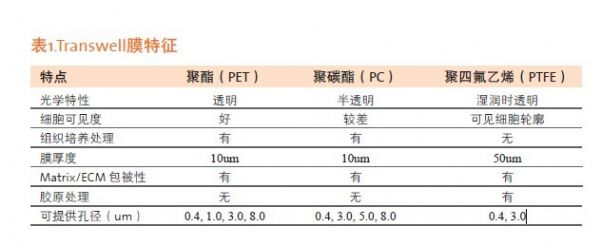Choose the right Transwell® membrane and pore size Cooking Sheet,Baking Sheet,Cookie Baking Sheet,Baking And Cooking Sheets Xiongyang Household Co., Ltd , https://www.yjkitchen-manage.com
The Transwell Permeability Support is available in three membrane materials: Polycarbonate (PC), Polyester (PET) and Collagen-Coated Polytetrafluoroethylene (PTFE). Table 1 provides more information on the properties of these membranes.
Polyester Transwell-Transparent Nesting features a film that is transparent under the microscope. These membranes are treated to allow cells to attach and grow better. Transwell-transparent nesting allows cells to be more easily observed under phase contrast microscopy and can estimate cell growth status and monolayer cell formation.
Polycarbonate Transwell nesting offers a variety of pore sizes from 0.1um to 12.0um. All membranes are treated to make the cells easier to attach.
Transwell-COL is a transparent, collagen-coated PTFE membrane that allows the cells to adhere and stretch more easily while being observed during culture. Transwell-COL contains equimolar mixed I and III extracted from bovine placenta
Type collagen. Unlike traditional coating techniques that form a sealed film, Corning's patented coating technology allows biostable collagen to wrap each fiber of the filter to maintain the porosity of the film.
Selecting the Aperture It is also important to select the appropriate pore size when using Transwell® Permeability Support in your experiment. Table 2 summarizes the general application of the permeability support and the recommended pore size. The smallest pore size Tanswell membrane (0.1 um) is mainly used for drug transduction studies. Cell invasion, chemotaxis and motility studies typically employ a Tranwell membrane with a pore size of 3.0 um or more.
The ability of cells to migrate through the pores of the membrane is related to the cell line and culture conditions chosen, as well as to the pore size. At less than 3.0 um pore size, cells do not migrate through. For some demanding experiments, Corning recommends using a series of pore sizes as a control in the experiment to determine which size is best for your cell culture and specific applications. Another way is to refer to the recommendations of published literature. For more usage and application information, please visit Transwell in the Technical Information section of the Corning website.
Permeability support application selection table applies recommended pore size super-molecules, ions, water, low molecular weight solutions, hormones, growth factors, ion channels, enzymes, transporters, receptors, lipids, polar distribution classification and targeted target polarity Formation and maintenance of tightly linked synthetic and assembly protein-switching membranes for circulating growth factors, hormones, antibodies, viruses, toxins, etc. Receptor-Phase interaction receptor localization and drug-reactive polar drugs for vascular permeability drug transport through the epidermis (Caco-2 cells) and endothelial barrier drug trafficking through brain microvascular endothelial cell tumor invasion and metastasis cloning detection of invasion inhibitors extracellular scaffolds phagocytosis in the blood of forming factors in the chemotaxis and tactile response of tissue macrophages Mobile cell-cell interaction cell-substrate interaction tumor heterogeneous cell-extracellular scaffold interaction feeder layer-stem cell interaction transduction and permeability study cell polar endocytosis drug transport transfer potential and invasive chemotaxis / Motivation studies co-culture of viruses, bacteria and parasites on host cell membrane attachment invasion and penetration Effect of barrier microbial receptor drugs on microbial receptors Microbial pathogenesis Mechanism of wound healing Angiogenesis Epidermal regeneration Inflammatory response Tissue remodeling Granulocyte culture Sterilization Endocrine and paracrine influences Granular differentiation, embryo sac hatching from transparent layer, substrate binding , trophoblast cell growth in vitro fertilization
0.4, 1.0, 3.0um
0.4, 1.0, 3.0um
0.4, 1.0, 3.0um
0.4, 1.0, 3.0um
5.0, 8.0, 12.0um
3.0, 5.0, 8.0um
0.4, 1.0, 3.0um
0.4, 1.0, 3.0um
0.4, 1.0, 3.0um
0.4, 1.0, 3.0um
Scanning electron micrograph of macrophages on Transwell polycarbonate membrane
B.Wetzel, S. Wahl, E. Westbrook
And L. Altma, NIH, Bethesda, MD
Gift)  Chemical Compatibility Hole Density Selection of Transwell Systems Traditional Transwell Permeability Supports All Transwell membranes are suitable for histological fixatives, including methanol and formaldehyde. Polyester Transwell membranes offer the best overall chemical suitability. These membranes (excluding polystyrene) are resistant to a variety of alcohols, amines, lipids, ethers, ketones, petroleums and other solvents including halogenated hydrocarbons and DMSO, but strong acids and bases are not recommended.
Chemical Compatibility Hole Density Selection of Transwell Systems Traditional Transwell Permeability Supports All Transwell membranes are suitable for histological fixatives, including methanol and formaldehyde. Polyester Transwell membranes offer the best overall chemical suitability. These membranes (excluding polystyrene) are resistant to a variety of alcohols, amines, lipids, ethers, ketones, petroleums and other solvents including halogenated hydrocarbons and DMSO, but strong acids and bases are not recommended.
Among the three types of membranes, only the collagen-coated PTFE membrane has no defined pore density because it has a membrane that is a tortuous tunnel. Two membranes having a nominal pore density are polyester membranes and polycarbonate membranes. The pore density of the polyester Transwell film is not as high as that of the polycarbonate film, but it has better optical clarity. The nominal pore density of the Corning polyester film and the polycarbonate film is shown in Table 3.
Traditional Transwell plate nesting is used independently in 6, 12 and 24-well plates and 10 cm culture dishes.
HTS Transwell-24 and HTS Transwell-96 nested in special specifications for easy handling and automatic handling.
Snapwell nesting is used in diffusion or Ussing chambers models.
Transwell permeability supports are available in three basic designs:
Detailed information about these products can be found below and in the ordering information.
May 12, 2021